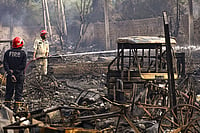
He Knows He’s A Cat
Ranthambore is perhaps the best place in the world to sight the tiger; they are unusually un-shy here, and frequently seen even in broad daylight. We had a wonderful sighting ourselves in the late morning: the jungle alarm system went off, with the cries of frightened deer and birds in the air. And then, a large tiger silently appeared about four metres from our open vehicle. It slowly, even casually, crossed our path to get to a rocky pool on our right. There, it drank, and then un-self-consciously lowered itself into the water to cool off from the heat. It lolled there for nearly twenty minutes before emerging, shaking itself dry, ambling back across our path, and disappearing into the dhok trees once again.
Recalling the folk-tale that the gods had created the tiger because man had become too fearless—and noticing the absence of an emergency weapon with our guide (unlike the safety practice in Africa)—I later asked wildlife photographer Mike Pandey if Ranthambhore’s tigers had become somewhat domesticated. “Don’t you believe that,” he replied, “Because you were sitting in that vehicle, he perceived you as some inanimate object. But if you had got off on foot, the hard-wiring in his brain would have immediately categorised you as prey. And you don’t want to know what could happen after that.” So what if someone needs to go visit the loo during the four-hour-long safari? “Ah,” said Mike quietly, “That can become a bit of a problem..”
Jinx-breaking, by the Book
The Vaastushastra prescribed six different types of fortress designs; giri-durg, the fortress protected by the hills; vana-durg, protected by the jungle; jal-durg, protected by water; dhanva-durg, protected by desert; mahi-durg, protected by mud; and nara-durg, protected by men. The great Ranthambhore fort is one of India’s finest examples of a vana-durg. One can almost see enemy armies trying to soldier through the outlying jungles, thick with tigers in those days. An ingenious defence system, indeed.
Ranthambhore was built in the 10th century by the Chauhans—one of the strategic keys to Rajputana. It’s had a tumultuous history: after Prithviraj Chauhan was defeated by Mohammed Ghori in 1192, the Chauhans withdrew to Ranthambhore, using it as a base to defy the Delhi Sultans for over a century. In 1299, however, they sheltered one of Allauddin Khilji’s rebel generals. Subsequently, Allauddin arrived with his armies and demanded his general be returned, a demand the Chauhans refused. The fort eventually fell, by treachery. Over the following two-and-a-half centuries, it changed hands many times.
In 1569, Akbar laid an epic siege to Rathambhore, then held by Rai Surjan of Bundi, and hoisted his artillery onto the surrounding hills, in a feat of military engineering. When the siege failed, he then pulled off an audacious political coup: he covertly entered the fort with his Rajput generals, as a humble fly-whisk bearer, and—before anyone got wise to what was happening—had himself placed on the throne. Ranthambhore remained a Mughal stronghold for the next two centuries, before passing to the Rajas of Jaipur.
Kipling’s Night-Song in the Jungle
If you’re packing just one book for a holiday in Ranthambhore, make it the Jungle Book. Angus Wilson, in his literary biography of Rudyard Kipling, writes of his travels through Rajputana, and suggests that they inspired the most vivid of all Kipling’s fantasies: the notorious “Cold Lairs” of the Jungle Book (who else but Kipling could have dreamed up such a sinister name?). Wilson speculates that the Cold Lairs were inspired by the deserted city of either Chittorgarh or Amber. I would argue that the brooding Ranthambhore fort would be a more likely inspiration, its lonely ruins are the perfect setting for evil lurkings. The vain, foolish “Bandar-log” still cavort on its pavilions; Kaa the python can be seen glistening in the ramparts; and after moon-rise, of course, comes the booming voice of Shere Khan from the dark forests just below..
The Hunters, The Gatherers
The history of shikar and of conservation were paradoxically interlinked in pre-Independence India. The maharajas who were keen shikaris were often also effective conservators, and their game reserves were well-regulated and managed. But that, of course, was a very different era.
Shikar was an important part of statecraft, and one of the best ways to achieve one’s diplomatic objectives was to invite the Viceroy and ensure that he had a memorable shikar. The most successful of these were the elaborate sand-grouse shoots organised by Maharaja Ganga Singh, whom the Brits referred to as “The Maharaja of Bikaner, by the Grouse of God”. One of the last shikars at Ranthambhore was hosted, coincidentally, for Queen Elizabeth, in 1960.
The history of shikar was also intertwined with that of warfare: in medieval times, shikar was often combined with military exercises. Prithviraj Chauhan, a legendary hunter, was often drawn into battle with his neighbours, it is said, because he’d stray into their territories while on shikar.






















